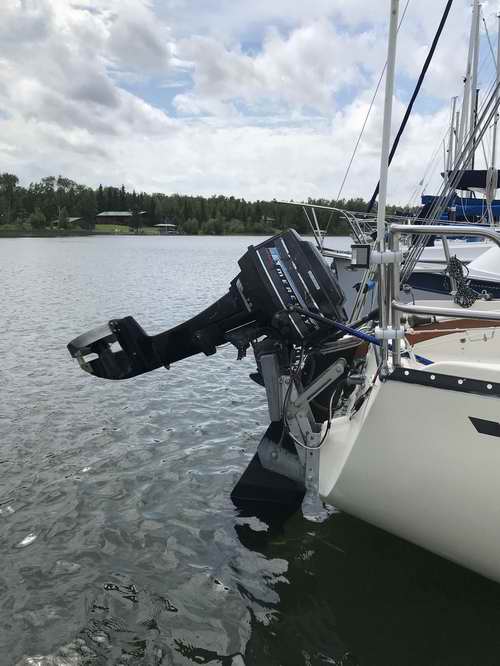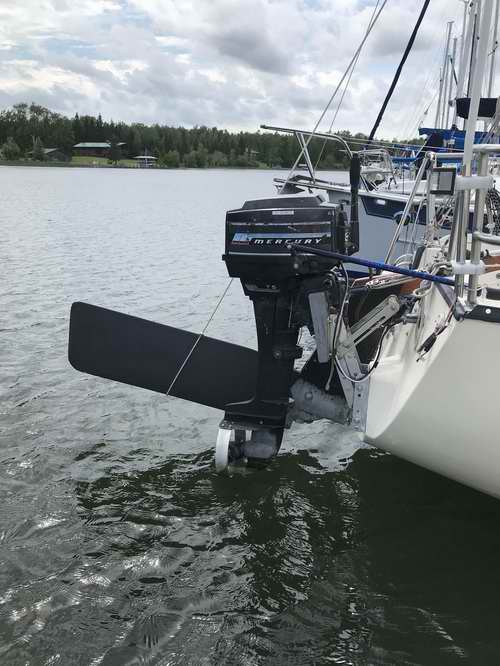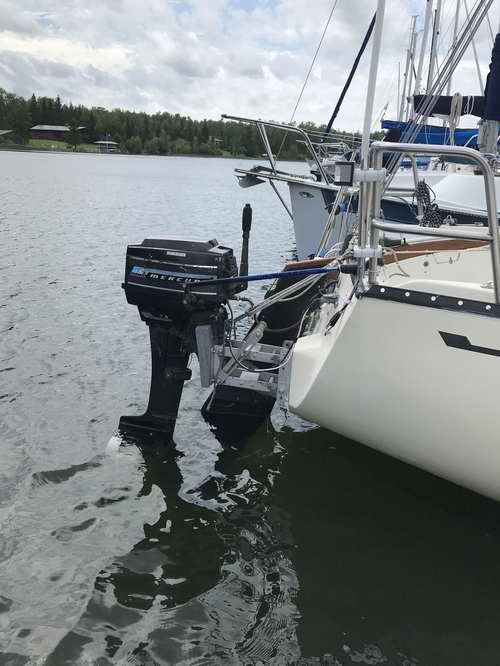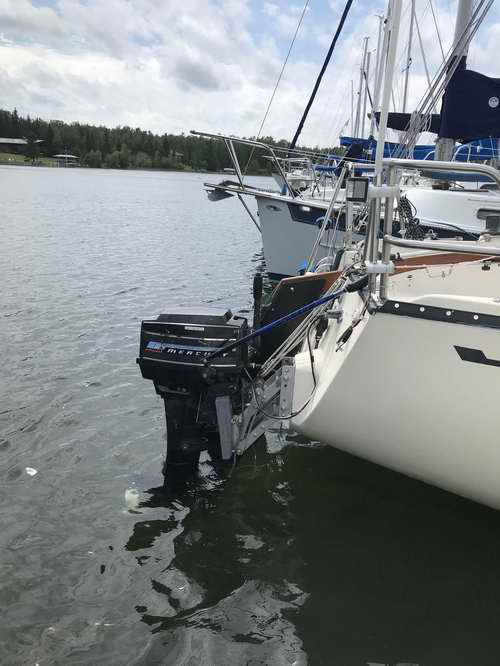| SJ23 Tech Tip D06, (Updated 2022-06-28) Bob Schimmel (Under Construction) | |||||||||||
|
Outboard HP Required to Push an SJ23 |
|||||||||||
| The
discussion of adequate horsepower for an outboard comes up every
now and then. For the benefit of all I've summarized the best comments
in this Tech Tip, added some theory and mixed in some of my experience.
THEORY - A planing hull rides on top of the water when it moves at speed. At slow speed it uses little power but then requires a lot of power to climb up on the "step" to plane. Once on the step, it requires less power to keep it there. A planing boat requires a high pitch propeller to match its fast speed.
A displacement hull like a SJ23 (2800 lbs empty) never gets up on the step as power is applied,
unless you apply a ridiculous amount of push to overcome all resistance, which
borders on explaining how a bumblebee can fly! Basically the hull
pushes the water aside as it moves forward through the water. What
water can't move away fast enough, piles up at the bow, creating a bow
wave. This may be impressive but it is a
waste of power. As the hull moves forward it also leaves a vacuum behind the transom,
evident by the shallow depression behind the wake. A wake is
created by splitting and pushing aside the bow wave. There is a
limit to how fast water can flow
from the pile at the bow,
around and under the hull, then into the depression at the transom.
A displacement hull requires a low pitch propeller, similar to first gear in a car. The optimum depth of the propeller below the bottom of the boat is dependent on many variables. When operating a displacement hull at low speed or when pushing a heavy load, a lot of blade surface area is required. So for a cruising sailboat, the prop should be below the bottom of the hull, spinning in clear water. It is more fuel efficient to push a displacement hull than a planing hull, but this has its limits too. If you keep the speed to around 5 knots you will consume less fuel than at 5.5 knots. Experiment with your throttle versus fuel consumption and you will quickly discover that beyond a certain speed there is no point in more throttle. In other words, hull speed refers to a velocity above which the surrounding water is non-laminar (turbulent). This implies wasted energy, as turbulent conditions dissipate a lot of energy. Put a 350-HP V8 in your SJ23 and you could likely make that baby plane! (or at least get home in a big hurry during a dead calm!). Please keep in mind that this discussion centers around efficient speed through the water, NOT ground speed over the bottom. Ground speed is required to go upstream or to get the hell away from conflicting traffic. This is something that a planing hull excels at. On the other hand, a planing hull also makes a lot of noise and messes up your hair in the breeze, but that's another issue! _____________________________________________ OUTBOARD TYPE - 4 cycle vs. 2 cycle
If you have to replace your outboard then consider the environmentally friendly choice and buy a four-cycle outboard. The lower fuel consumption, emissions and quieter operation are not to be discounted. They burn cleaner, with more thrust, and are therefore more reliable than their 2-stroke equivalent. On the other hand, fuel injected 2 stroke outboards are at the same efficiencies and low pollution of a 2 stroke (2015). If you continue to use your older 2 stroke outboard then use Amsoil synthetic two-stroke oil (or equivalent) to keep your spark plugs clean and reduce your oil pollution by at least 50% over mineral oil. Amsoil 2 stroke oil is mixed at 100:1 for an outboard that normally requires 50:1. I regularly mix the oil for Panache's Merc 7.5 at 150:1 with no detrimental effects. In fact this oil is so good that some snow mobile racers around here mix it at 250:1 for their Skidoos. Don't do this in an outboard though. All of us appreciate a clean environment. Just because sailors don't operate their outboard as long or burn as much fuel as a powerboat, doesn’t excuse you from polluting the water. Every one of us is part of the problem and part of the solution. OUTBOARD HORSE POWER - Be careful when making a HP comparison between an older and a newer outboard. The HP rating for an outboard changed in the mid 1980s. Some mechanics say it was around 1986 when the rating became universal for outboards since it was necessary to equate the thrust between propeller and jet drive units. The two had different power conversion factors. Prior to the change the HP of an outboard was rated at the power head and afterwards the HP was measured at the propeller. I believe this was also done as a more equitable means of comparing 2 & 4 cycle outboards, especially since the electric trolling motors are rated in thrust. In the final analysis who cares how much horse power the outboard has (except for a licensing issue). What you should care about is how much thrust the outboard produces and if the outboard is overloaded at that throttle setting. I'm sure this factor plays in the various opinions of SJ23 HP requirements listed below. Two other factors are up for consideration; weight and noise. 80 pounds should be the limit to hang an outboard on the transom and expect decent sailing performance. The other is noise, not to be discounted when motoring a long distance. 4 stroke are usually quieter than 2 stroke. I miss that about my Honda 4 stroke.
_____________________________________________
CHOICE OF LONG SHAFT or EXTRA LONG SHAFT - On a planing hull the cavitation plate should ride even with the bottom of the hull. On a displacement hull the cavitation plate should ride deeper than the bottom of the hull to keep the prop in the water in steep seas. The deeper the propeller is in the water, the more dense the water. A deeper propeller results in more efficient thrust for maintaining push in big or steep waves and reduced fuel consumption. Additionally a deep prop will usually stay in the water when you work at the bow. This is another reason why the cavitation plate should be at least 6" below the surface when the hull is level.
In the cases described above, a log shaft 1975 outboard (equivalent to extra long in 2020) will ensure that the prop stays under water, maintains vessel control plus protects the water pump & outboard cooling. If your prop comes out of the water often then add a long shaft conversion kit to the outboard, or lower the outboard bracket. To be more specific, Panache's 1974 7.5HP long shaft Merc has a shaft length of 22", measured from inside the mounting clamp to the cavitation plate. I modified the outboard bracket to lower it further than original so that at the bottom of the pivot the cavitation plate is about 6" below the surface. But without modifying the outboard bracket I would buy an extra long shaft outboard to deal with the short steep waves on the lake I sail on. In the photo of the ducted propeller below I've tried to show how deep the prop rides but it is difficult to portray accurately. (UPDATE) Therefore I'll try to take the following photos this summer to demonstrate outboard operation at the listed speeds.
|
|||||||||||
|
PROPELLER THRUST - The pitch of the stock propeller for most small outboards is designed to push a light weight aluminum fishing boat at planing speed, not a 3000 pound displacement sail boat at 5 knots. On a planing hull the outboard can rev freely and cool properly pushing a light load near the top of its designed RPM. When using the stock propeller to push a displacement sailboat like an SJ23, the outboard will generally operate in the bottom half of the RPM or torque range. This may overload the outboard resulting in overheating and accelerated wear. Fortunately a sailboat is relatively easy to push through the water. Be wary of the throttle setting on your own outboard. Find the setting that produces maximum speed with minimum throttle and operate at it. If you throttle up beyond that you will burn extra fuel with very little speed increase. Don't operate in this range. To increase the thrust you could change from a 2 bladed propeller to 3 bladed propeller that has more bite. Failing that you could install a fin pitched propeller, which usually has three blades anyway. Either change will achieve more push and longer outboard life. A three bladed propeller for my 7.5HP Merc was difficult to find and turned out to be cost prohibitive. The fine pitched propeller, especially if it has three or four blades, is excellent for accelerating, towing, punching into a current or waves and really comes into its own when backing up or stopping. The high thrust blades are generally quite flat and round shaped (like a lily pad) versus the screw shaped propellers designed for speed. The down side is the outboard will make more noise at the higher RPM. It should be noted that a 4 cycle outboard generates more torque at a lower RPM than a 2 cycle outboard and is therefore is a better choice for pushing a displacement hull.
I fabricated this duct from 3" wide aluminum sheet.
The
1/8"
thick aluminum was persuaded (pounded) to a circle over a 6" diameter pipe to
create a ring with 1/2" space around the propeller. The
shaping required lots of "tender tapping" with a short handle 5 lb sledge!
The ring is bolted to the bottom of the cavitation plate
and to the skeg by two support brackets, all with SS screws. The duct MUST be centered around the
propeller and should be positioned ~1/3 forward and ~2/3 aft of the blade tips. The marine and air craft nozzles are equipped with an internal foil to increase the thrust. This one obviously doesn't have that. The photo
above shows the outboard on the transom in the lowered position with the top of the prop a bit below the water line. This view is a bit misleading in that the top of the prop in drive mode is actually well below
the water line. The waves have to be really steep and
short for
this prop to come out of the water.
At right you can see the outboard pushing the hull at 5 knots in flat
water. There is virtually no turbulence and the tiny exhaust bubbles
come to the surface about a boat length back, much smaller and further than without the ring. Click on Line Guard for size criteria for your outboard. A Line Guard costs about the same as a 3 bladed Mercury propeller and is a lot quicker to install. Just don't expect the push of a tugboat or the acceleration of a Boeing 737, OK! PERFORMANCE TEST 2008 - A few observations I made on a 12 mile run with Panache:
REMOTE CONTROL - See Tech Tip D07.
|
|||||||||||
| Q&As -
"I'm wondering if the choice of a 6HP or an 8HP
outboard is based on using the boat on a
lake, river or coastal area such as Puget Sound where you can expect
tidal current with wind?"
Mike (This
is the original question that prompted me to compose this Tech Tip. Bob).
REPLY 1 - Mike I have an 8HP Merc on a 22' Westerly on the Gulf of Mexico and ICW and would not consider an outboard over 9HP. A Westerly 22 is a twin keel boat that weighs more than a SJ23. There is no reason or benefit to a big outboard on a displacement hull. You will never be able to water ski on a sailboat and you will just stress the hull with too much power. I have powered with those little Johnson canoe kicker outboards that I keep in the well for a spare. Rather that spending bigger bucks on a bigger outboard, reef down and sail it home when the wind gets too strong. (Get reef points in your sail and be sure you know how to use them). I had a 9.9HP on a 20' Balboa and it was overpowered. I never could use full throttle. My next outboard will be the best quality used 6 to 9.9HP I can find, purchased by weight and price, and not a lot of regard to HP. Paul Halenbeck REPLY
2 -
Sailing weight and attainable speed are certainly important
considerations in the choice of auxiliary power, but they aren't the
only considerations. Including the outboard mount replacement, the 15HP
two-stroke I now use weighs about ten pounds more than the 7.5HP I
retired. I can rationalize the extra weight pretty easily, but then
I'm not a racer. If it
bothers you, leave some of your beer at home or get
skinnier crew. Attaining hull speed at half throttle is adequate
compensation for the extra weight, due to reduced noise
and vibration and generally less stress on the outboard.
I won't ever pull water skiers, but I might need the extra thrust
someday. REPLY
3 - I
have a SJ23 Mark II with an 8HP 1991 Suzuki.
The outboard is very reliable, and propels the boat at hull speed
at about 3/4 throttle. I
have wondered if it would be better to have a 6HP to reduce weight, but
appreciate the wisdom of an earlier message indicating that operating at
full throttle may wear out the outboard faster.
As well, my outboard does not perform particularly well in reverse;
a smaller outboard would presumably do worse. REPLY 4 -
The prop will make all the difference. Go for the high thrust four-blade
model. REPLY 5 - I have a brand new 2 cycle 4HP Mercury on my SJ24. The boat will do hull speed at about 3/4 throttle. The gas tank is self-contained with the outboard so no fuel tank or hoses to mess with. What more do you need? Mike Chaney, SV Pog Mo Thoin. REPLY 6 - I have used a Honda 7.5HP and other 6HP outboards on various SJ23s on Puget Sound. They all work fine. More HP means more weight and more weight means less performance under sail. The SJ23 has a finite hull speed and overdriving the hull burns more fuel, with not much more speed. Gene Adams. REPLY 7 - I use a 7.5HP long shaft Mercury equipped with electric start and generator. The center of the prop is 27" down from the top of the transom and it usually runs about 12" deep. It performs very well in lake sailing and achieves about 5 knots in flat water at 1/3 throttle. If I throttle up, it makes a lot of noise and burns a lot of fuel without going much faster. In really rough water I once tried punching to weather in 4' peaky waves at 4 knots with 1/2 throttle. However, the hull took a lot of pounding, the rigging took a lot of shock loading and my teeth did a lot of chattering. Therefore I now "tack" into the waves to smoothen the ride for the hull and rigging plus reduce the load on the outboard. This has the advantage of increasing the speed through the water and reducing fuel consumption. While I like the outboard, a four stroke (quieter, lower fuel consumption & higher thrust) with top mounted controls would be nice. When I added the duct around the propeller it reduced the fuel consumption by ~40% at 5 knots. One day I may replace the standard two blade propeller for a three blade to improve the reverse thrust. This outboard is such a sweet combination that I doubt I will ever replace it. Bob Schimmel, SV Panache. REPLY 8 - We had an outboard failure last summer while trying to leave the dock so we rented the marina's outboard to complete our haul out. Unfortunately it was a short shaft of 8-9HP. I can't remember the make, not a Johnson or Honda, maybe Nissan. We mounted it as low as possible and moved all of our gear aft, sat on the stern and almost went crazy trying to keep the water pickup under water while we motored to the travel crane dock. From this experience I would never consider buying a short shaft. Our outboard bracket has the hydraulic lift assist and tilt features to make life easier and we never leave any part of the outboard in salt water except when under power. Betsy Schultz. REPLY 9 - If you've read the past posts and you've run into mine that tout the Honda 7.5-10HP family of outboards, please forgive. There is everything to love about this series except lifting them onto the engine bracket, as they weigh a bit over 80 lbs. Beyond that, you get reliability, relatively quiet operation, and hull speed at a little over 1/2 throttle. When you need to push hard into a headwind, there is still reserve thrust available. Then there is the added benefit of having a charging system for the house batteries. |
|||||||||||
|
|||||||||||
|
Return to Tech Tip Index. . . . . . . . . . . . . . . Have a Question? |
|||||||||||



